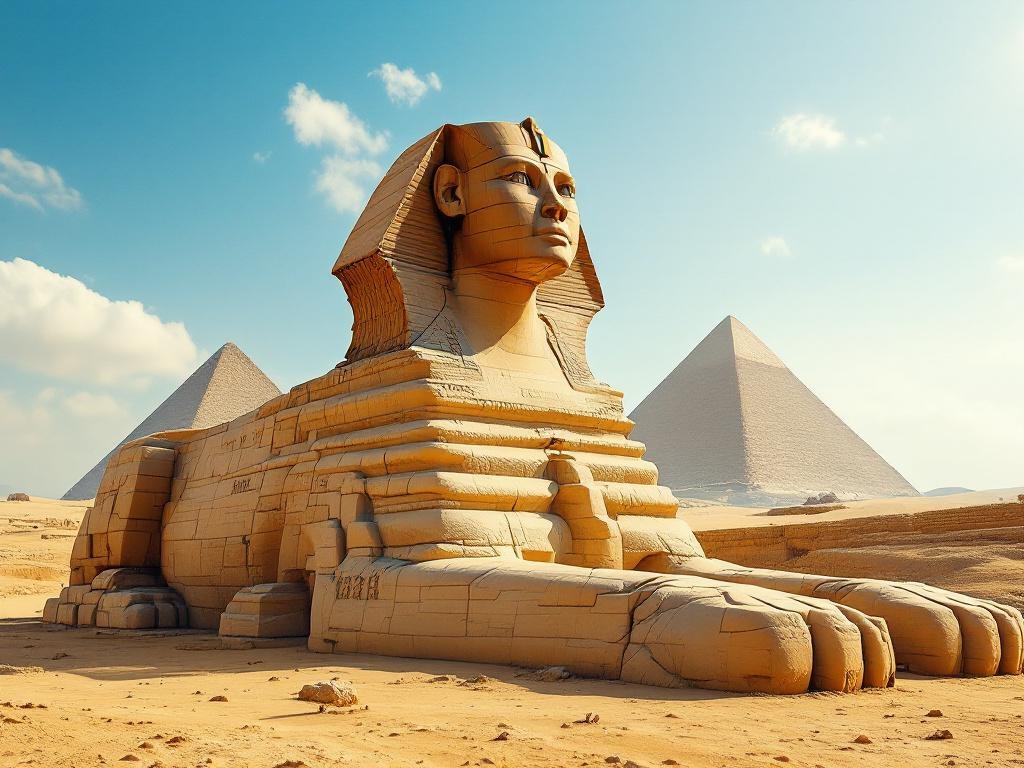Discovering the Great Sphinx of Giza
Journey to Egypt’s Giza plateau and behold the Great Sphinx, a colossal limestone statue that has captivated the world for millennia. This enigmatic monument, with its lion’s body and human head, stretches over 240 feet long and stands 66 feet tall, carved from the very bedrock it rests upon. Discover the secrets of this ancient marvel, built during the reign of Pharaoh Khafre around 2558-2532 BC, that served as a guardian of the Giza pyramids. Uncover its rich history, explore ongoing conservation efforts against erosion and climate change, and delve into the symbolism behind this iconic testament to ancient Egyptian ingenuity. Read on to unlock the mysteries of the Great Sphinx.
Important information

- Located on the Giza plateau near Cairo, the Great Sphinx is a massive limestone statue depicting a reclining sphinx (lion’s body, human head).
- It’s one of the world’s largest single-stone statues, measuring 240 feet long, 63 feet wide, and 66 feet high.
- Built during the 4th Dynasty of Egypt’s Old Kingdom (circa 2558-2532 BC), it’s believed to have been commissioned by Pharaoh Khafre.
- The Sphinx served as a symbol of royal power, divine protection, and the pharaoh’s connection to the sun god Ra.
- Currently, the Sphinx faces threats from wind erosion, pollution, and climate change, prompting ongoing conservation efforts.
The Great Sphinx of Giza: An Icon of Ancient Egypt
The Great Sphinx of Giza, a majestic limestone statue, stands as an iconic symbol of ancient Egypt. Located on the Giza plateau near Cairo, this colossal monument depicts a reclining sphinx, a mythical creature with the body of a lion and the head of a human. It serves as a powerful testament to the ingenuity of its ancient Egyptian creators and remains a popular destination for tourists visiting Egypt. Before you travel, make sure you have the necessary visa or permits. Check the latest entry requirements here: Check the latest entry requirements here
Positioned near the three Great Pyramids of Khufu, Khafre, and Menkaure, the Sphinx faces eastward, greeting the rising sun. Its immense size is truly impressive, measuring 240 feet long, 63 feet wide, and 66 feet high. This makes it one of the world’s largest single-stone statues, carved from the very bedrock of the Giza plateau itself.
Key facts about the Great Sphinx:
- location: Giza plateau, near Cairo, egypt,
- depiction: reclining sphinx (lion’s body, human head),
- size: 240 ft long, 63 ft wide, 66 ft high,
- material: limestone bedrock,
- significance: iconic symbol of ancient egypt.
Location and Orientation on the Giza Plateau
The Great Sphinx is located on the Giza plateau, approximately 800 meters from the Great Pyramids. It faces east, symbolically greeting the rising sun and connecting it to sun gods. Its eastward position also physically links it to the valley temple of Khafre’s pyramid. Scholars speculate the Sphinx may have been a ritual site, while another theory suggests it represents the Pharaoh in divine form.
Dimensions and Monumental Scale
The Great Sphinx is a truly massive structure, towering over 20 meters (more than 65 feet) high and stretching over 73 meters (about 240 feet) long. This colossal size makes it an imposing figure on the Giza plateau, a testament to the ancient Egyptians’ incredible engineering and artistic skill.
Construction Material: The Limestone Monolith
The Great Sphinx, a monumental sculpture, was carved from a single block of Mokattam Formation nummulitic limestone. This sedimentary rock, readily available on the Giza plateau, served as a practical material for this and other large-scale construction projects in the region.
Historical Significance and Cultural Context
The Great Sphinx, a monumental statue from Egypt’s Old Kingdom (circa 2500 BC), stands as a testament to royal power and divine connection. Built during the Fourth Dynasty, its construction is mostly attributed to Pharaoh Khafre (2558-2532 BC), though some suggest it was Pharaoh Khufu. Its purpose was to safeguard the Giza pyramids, embodying the pharaoh’s strength, wisdom, and authority. The Sphinx likely depicts either Khufu or Khafre, symbolizing their regal status and link to the gods, reflecting the ancient Egyptians’ profound cultural beliefs.
Built During the Reigns of Khufu or Khafre
The Great Sphinx is widely attributed to Pharaoh Khafre, who reigned from 2558-2532 BC and also constructed the Second Pyramid at Giza. However, some scholars argue for an earlier origin, suggesting his father, Khufu (2584–2561 BC), builder of the Great Pyramid, may have commissioned it. This ongoing debate notwithstanding, the Sphinx’s association with Khafre strengthens the perceived link between these iconic monuments and the Old Kingdom’s royal lineage.
Purpose: Guardian of the Giza Pyramids
The Great Sphinx of Giza, a potent symbol of pharaonic divinity, stands sentinel over the pyramids. It likely depicts the sun god Ra, safeguarding the pharaohs’ tombs within. Some theories, however, propose an astronomical link, suggesting the Sphinx aligns with certain celestial bodies. This adds another dimension of intrigue to this ancient marvel.
Symbolism and Representation in Egyptian Culture
The Great Sphinx, a potent symbol of royal power and divine protection, stood guard over the Giza pyramids and the pharaohs entombed within. Its traditional pharaoh’s head and lion’s body symbolized the potent blend of human intellect and animal strength, linking the rulers to the sun god Ra and reinforcing their divine authority. The Sphinx also embodied the pharaoh’s vital role in upholding Ma’at, the ancient Egyptian principle of order, truth, and justice.
The Sphinx’s Architectural and Engineering Prowess
The ancient Egyptians used incredible techniques to carve the Great Sphinx from a single, enormous limestone bedrock. Imagine shaping this colossal monument with only copper tools and stone hammers! This immense undertaking required skilled workers, meticulous planning, and advanced quarrying techniques. The Sphinx also holds astronomical significance, aligning with key sun deities, which reflects the builders’ profound knowledge of the cosmos and their spiritual beliefs.
Construction Techniques and Ancient Stonemasonry
The Great Sphinx, carved from a single limestone bedrock, stands as a testament to the ingenuity of ancient Egyptian stonemasons. While the exact construction methods remain a mystery, theories suggest workers from nearby settlements used various tools to shape the stone. This magnificent monument showcases sophisticated engineering and precise carving techniques, a remarkable feat of human skill.
Alignment with Solar Deities and Astrological Significance
The Great Sphinx, facing east, aligns perfectly with the rising sun, connecting it to solar deities like Ra. This orientation highlights the sun’s importance to the ancient Egyptians. Their reverence for astronomy and solar symbolism is evident in their architecture and religious practices. They believed the sun was a powerful, life-giving force.
Restoration Efforts and Conservation
The Great Sphinx has undergone restoration efforts since the 14th century BCE, beginning with Thutmose IV. Modern conservation techniques leverage advanced technology, including 3D scanning, to monitor the structure and promptly address any developing issues. However, the Sphinx continues to face threats from wind erosion, pollution, and rising groundwater levels exacerbated by climate change. Archaeologists are consistently uncovering new details about the Sphinx’s history while simultaneously working to stabilize and safeguard it from environmental damage. This ongoing work ensures that this ancient wonder will endure for generations to come.
Historical Restoration Projects
Early restoration attempts using soft limestone worsened the Sphinx’s condition. Later projects employed stronger materials and focused on scientific methods like stone consolidation, cleaning, and protecting the Sphinx from wind and water. Research into the Sphinx’s construction and careful documentation guide ongoing restoration work.
Challenges: Erosion, Climate Change, and Iconoclasm
The Great Sphinx faces a formidable array of threats. Relentless wind and sand erosion eat away at its limestone core. The escalating effects of climate change, including rising temperatures and increased rainfall, accelerate the monument’s decay. Human actions, such as the infamous damage to its nose, further scar the ancient wonder. Preserving the Sphinx against these combined forces is an ongoing battle.
Modern Conservation Efforts and Archaeological Work
Experts are collaborating to safeguard the Great Sphinx. Archaeologists and conservationists use cutting-edge technology to monitor its structure and analyze the limestone. Their current work focuses on environmental threats, such as wind and sand erosion. Preservation efforts aim to mitigate this damage, while restoration projects stabilize the Sphinx and prevent further decay.










